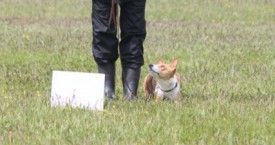There are many sporting activities that you can enjoy with your dog. From confirmation dog showing and obedience to agility and dances with dogs. Dog sport literally caters for every man (or woman) and his, or her, dog!
DOGS Victoria is the state controlling body for most dog sports in Victoria. Participating in dog sport has a number of positive effects on our pets and ourselves; mentally stimulating (for both). For the owners the thrill of training, the exhilaration and reward of the occasional win, and the dog just continues to love it – win or lose! Some sports keep the humans as fit as the dog! All in all there is a sport for every person and every dog…….’dog sport’ – what weekends were made for!
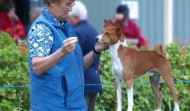
Basenjis are ‘tabled’ The judge will approach and ‘go over’ the dog, checking its bite, that a male is entire, its conformation, temperament, how closely it resembles the ‘breed standard’ which is the blue print on the breed that all breeders strive to achieve.

Once the judge has ‘been over’ the dog, the handler will be asked to ‘gait’ or run, his dog around the ring, the judge evaluates the dogs movement to ensure that it matches the breed ideal.
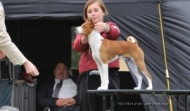
Conformation dog shows are enjoyed by people of all ages. The VBBA encourages our younger members to take up the sport in junior handler heats. Our junior handlers are the breed’s future. The VBBA takes its role in nurturing our junior members seriously to ensure that our breed has a succession plan for the future. Junior handlers learn the in the art of ring craft, sportsmanship and responsible dog ownership…
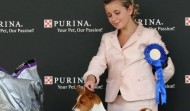
And of course winners are grinners – some ones dog has to win! But as we often say to ourselves, we are taking the best dog home, there is another show next week….and so it all begins again….
Why do we show our Basenjis?
Primarily we show our Basenjis for the fun of it. Showing in Australia is generally a relaxing day out, some country shows have beautiful settings. After the breed is shown, generally about 15 minutes or so, there is plenty of time to sit talking and watching the other breeds. Showing allows you to interact and communicate with your dog. Handler and Basenji must work together in front of the judge and onlookers. Showing has its serious side too; preservation of a beautiful and ancient breed and yes it is competitive but if not taken too seriously that adds to the fun. As long as you always remember that, whatever the result, you are taking home the best dog, you will be sure to return…..yes it can be addictive.
How do I start showing?
Firstly your dog must be registered with the Canine Control Council of your State (DOGS Victoria also known as the Victorian Canine Association is the state canine control council here in Victoria). The owner of the dog must also be a member of the State’s Canine Control Council. Then you can start showing.
Which Group does the Basenji belong to?
There are over 150 different dog breeds recognised in Australia. To make things easier to manage there are strict routines set out for the running a show. Breeds are ‘grouped’ together into 7 groups.
Basenjis are used by people in the Congo for hunting. Dogs used for sight/scent hunting or both are grouped in the Hound Group (Group 4) and this is the group in which Basenjis are shown in Australia. There are 7 Groups in Australia, The Toy Group (1), The Terrier Group (2), The Gun Dog Group (3), The Hound Group (4), The Working Dog Group (5), The Utility Group (6) and the Non Sporting Group (7). Dogs are grouped together with “like” dogs, for example Terriers of all shapes and sizes are included in the Terrier Group.
How does the show work?
Basically a dog show is a process of elimination which eventually leads to the one dog becoming the “Best In Show” – this dog has not been beaten by any other dog in the show. Members of the VBBA are very friendly and helpful to all new comers. Our members will help you fill in your entry form and will be happy to give you some handling lessons.
Firstly dogs compete against dogs of the same breed, age, and sex. The winners of all the different age groups (still against the same sex) “challenge” each other for the best of sex, known as the Challenge Dog (male) and Challenge Bitch (female). The Challenge Dog and Challenge Bitch then compete for Best of Breed (BOB).
Next all the best of breeds (BOB’s) in each group compete for the Best in Group (BIG). The 7 best in group winners compete for Best in Show (BIS). This is simplified version of what takes place – there are a few other parts to the show.
How does the judge make his decision?
Each breed has a written standard a blue print for the characteristics of each breed. The judge evaluates each dog against this standard and selects the dog or bitch which he feels most exactly matches the standard. During the process the judge will evaluate the dogs confirmation (its structure, position and length of bones and its musculation), its soundness (physical and mental condition) an unsound dog may be one that is lame or one that has undesirable behaviour. The same method is used when all the dogs in the group compete for BIG. The judge is looking for the dog which matches its standard most exactly. When it comes to BIG and BIS the dogs are competing against the standard rather than against each other.
How does a dog become an Australian Champion?
A dog must accumulate 100 points to become an Australian Champion. The highest number of points allocated at any show is 25 points. If there are more than 20 dogs in the group the dog who wins Best in Group, receives the maximum 25 points. Therefore a dog can become a champion in four shows as long as four separate judges have awarded the dog. In Australia a dog cannot become a Champion until it is over 12 months of age. 25 of the 100 points required must be won after the dog is 12months old.
Points are allocated to the Challenge Dog and Challenge Bitch. The points are calculated on the number of entries, for example if there are 3 Dogs entered the Dog Challenge winner would receive 8 points, that’s 6 points for the challenge plus one additional point for each dog defeated, 6+2=8. If there is only 1 bitch entered and the bitch is awarded the Challenge then the Bitch would receive 6 points. The Best of Breed winner also collects 1 extra point for each dog of the opposite sex defeated. So if in our example the Bitch was the BOB winner then she would receive a total of 9 points; 6 points for her challenge plus 3 points, 1 point for each Dog. If the Dog had won BOB then he would have received 9 points; 8 points for his challenge and 1 extra point for each Bitch he beat in this case he beat one.
The judge can refuse an award if he/she feels the dog/bitch is not worthy of the title “Champion” in this case the dog/bitch would not receive any points. Once your Basenji has gained the required number of points he will become an Australia Champion. His registered name will be prefixed by ‘Ch.’ which indicates the dog has attained the title.
In Australia have two more conformation titles
- Grand Champion. To gain this title dogs must have won 1000 points.
- Supreme Champion. To gain this title dogs must have won 1000 points including 3 All Breeds Best in Shows or 10 Best in Group or Best in Specialty show – all must be under different judges, no repeat judges allowed.
Is any training required?
Yes, your Basenji will need some training in order to be shown successfully. Although the dogs in the ring are not doing the usual obedience sit, stay drop etc. training is none the less important. Your dog must allow a stranger to approach him, to look at him for long periods and to touch and feel him all over. He must allow this stranger to open its mouth in order to look at his teeth. All of this can be quite intimidating for a dog. Your dog must gait (move around the ring) at his most ideal speed without breaking his trot so that the judge can view his movement. Your dog must remain motionless for periods of time (not easy with a Basenji) whilst the judge looks at him and the other dogs. The judge may only look at your dog for a few seconds and if he is not standing (known as stacking) in a position to show him to his best then he may not get another chance.

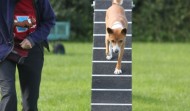
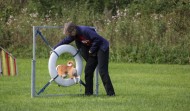

If you’re looking for a dog sport that provides a release of energy for your Basenji, as well as mental stimulation, then look no further. Agility will exercise your Basenji in a way that can be much more interesting and exciting than simply taking your dog for a walk. Handlers are always encouraged to train positively with plenty of tasty food rewards and fun toy games to keep your Basenjis interested in the sport.
Agility is a fun, fast and exciting sport that attracts all breeds of dogs. It can be done at a competitive level, or just for fun as a great outlet for your Basenji to race around and jump! The obstacles in an agility course may include various types of jumps, ramps, elevated walks, weaving poles that the dogs weave through, tunnels and a see-saw. Agility is very much a team sport, with the handler directing their dog through the course to negotiate obstacles correctly and in competitive agility, to get the best time possible.
Basic agility training can be done on lead to help control and direct your Basenji over jumps, through weave poles and up ramps. As the training progresses, agility it is performed off lead so basic obedience is required. Most obedience and agility clubs require your dog to be at least 1 year of age before serious agility training can commence to allow your dog to become fully grown and joints properly developed.
If you’re looking for a dog sport that provides a release of energy for your Basenji, as well as mental stimulation, then look no further. Agility will exercise your Basenji in a way that can be much more interesting and exciting than simply taking your dog for a walk. Handlers are always encouraged to train positively with plenty of tasty food rewards and fun toy games to keep your Basenjis interested in the sport.
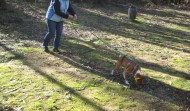
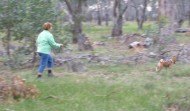
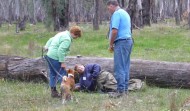
Tracking is harnessing the dog’s ability to follow a specific scent trail.
Tracking can’t be taught to a dog. All dogs have the ability to follow a scent trail. Depending on the conditions, a dog can pick up a scent 800 metres away.
In tracking trials the dog must follow a scent trail laid by a tracklayer, and along the way find objects [scent articles] dropped by the tracklayer. The time interval from when the tracklayer starts to when the dog starts can be from 20 minutes for test 1 to 3 hours plus for TSDX.
The tracking surface starts with good vegetation i.e. grass for beginners to pavement and sealed roads for more advanced dogs. Tracking is a great way to build a strong bond with your dog and challenge his mind.
Remember to trust your dog. He has the “nose”.
The equipment required for Tracking is a webbing harness and a 10 metre webbing lead. The normal width of the webbing that we have found suitable is approximately 1 inch in width. A harness we have found suitable for our Basenjis was bought online through http://stores.ebay.com.au/YIPYAP-designer-dog-wear. The store owner has a wide range of leads and collars (very reasonably priced) and she knows what we like for the Basenjis. She is excellent to deal with.
As Tracking is a dog sport conducted through the cooler months and in all weathers – your Tracking clothes should be warm and waterproof. A strong pair of preferably waterproof shoes, parka, fleece jacket, fleecy pants, and thick socks.
And believe it or not – when your Basenji is on a ‘track’ they couldn’t care less about the weather!!
The Tracking Club of Victoria Inc conducts a Tracking Workshop weekend each year. This is an excellent way to start a new dog. There are some Obedience Dog Clubs that hold Tracking classes as well.
The link for the Tracking Club of Victoria Inc is http://www.trackingclubvic.org.au
Training for endurance will not only build your dog’s stamina but yours as well.
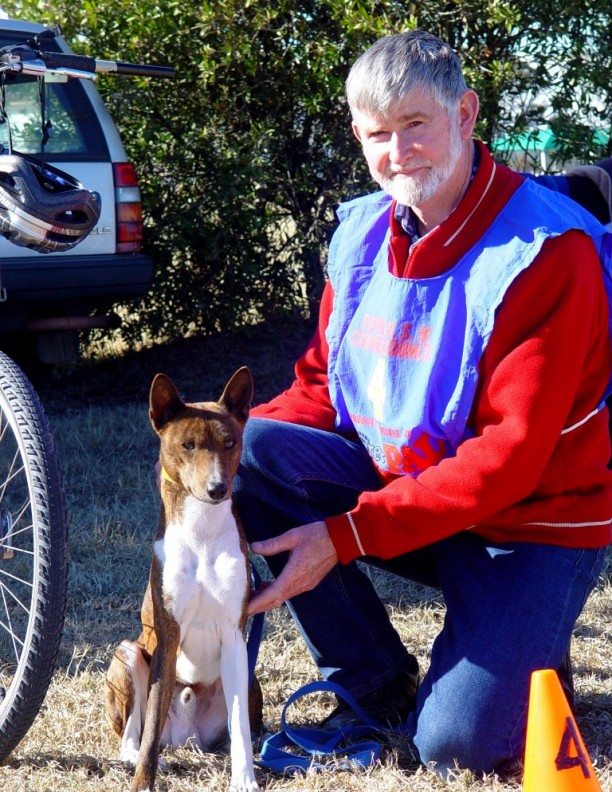
So what can you expect, if you decide the Endurance Test is for you and your dog?
The Endurance Test is a winter pursuit – the test will be terminated (no matter how far through the test the dogs are) if the temperature rises above 24 degrees centigrade. So be prepared for a very early and very cold start. To compete, firstly your dog must be a minimum of two years of age and a maximum of seven years of age. In Australia the dog must be registered with a Canine Controlling Body to be eligible to compete.
Dogs must be vetted by a Veterinary Surgeon within 14 days prior to the Endurance Test. The check covers general health & fitness, temperament, standing heart rate, condition of pads and muscle tone.
When you arrive at the Endurance Test location you hand in your Vet Certificate at the Marshalling area and undergo a further preliminary vet check. Next comes a basic obedience exercise consisting of heeling, forward on the lead, a sit, a stand and a right about turn. You also do a recall, either on or off lead.
Then you start on your way – The dogs are gaited on a two-metre lead beside you either riding a pushbike or jogging across a combination of grass, dirt and bitumen or concrete surfaces.
You are accompanied throughout the test by a pace person (either on a bike or jogging), and a judge (usually on a pushbike) to make sure that the test is completed in the prescribed time and that all dogs maintain their pace and complete the test as required.
After the first leg of eight kilometres, all dogs are vetted again. Then comes a fifteen-minute break for you and your dog to have a drink and rest before staring off on the second leg of six kilometres, which is followed by a further vetting session and a twenty-minute break.
The third and final leg is again six kilometres – the telling leg, not for the dogs because they are just getting into the swing of the test, but for their human companions – sore bottoms are the order of the day after 20 kilometres of pushbike riding, or sore feet and legs from jogging.
After turning back into the marshalling area on the final lap, both dog and companion have a fifteen-minute break before the final vetting session. The judge then takes you back into the obedience ring and you repeat the basic obedience test.
At the conclusion all successful dogs will be awarded the title of Endurance Test and be able to have the letters E.T. proudly included at the end of their registered name.
Training for your Endurance Test – A VBBA Members experience.
Andy commenced his training regime four months prior to his Endurance Test (two months is usually sufficient), but being a natural over achiever, Kerry (Andy’s trainer) decided to structure a longer training program to work around his 12-hour shift roster.
Kerry would start each training day with a short basic obedience session and then go for a bike ride – starting out at a two-kilometre maximum and gradually building up to their self imposed 12 kilometres maximum. Having reached their maximum, the trick is to keep your dog at maximum fitness so for the last month Kerry and Andy were covering 10 kilometres every third day. After each training session Kerry would then take Andy for a kilometre walk to ‘cool him down’ before releasing him to his kennel.
What part did I play in Andy’s fitness program, not a great deal, however it fell to me to make sure that Andy maintained his weight, not an easy task when he was literally running off all the food he ate. I also walked Andy 30 minutes every day – at night – to support his daytime training sessions with Kerry on the bike.
Did Andy enjoy his Endurance Title – I am certain he did as his fitness levels were supreme – my aching arms and legs were testament to his fitness and ability to ‘power walk’. His confirmation showing results also reflected the benefits of his Endurance Title – he has won more in the show ring in the past twelve months than in his entire show career.
Would I recommend doing an Endurance Title for you and your dog – YES – not only do you build a special bond with your dog, you both get fit and the benefits of an improved fitness are tangible.
The DOGS Victoria website has more on the endurance test and rules governing it.
Lure coursing allows your Basenji to do what comes so naturally to him being a sight hound! It taps into their natural instinct to run at high speeds chasing an object off lead. Lure coursing is often done in a safe and secure area that is fully fenced and without obstacles so even the most disobedient of dogs can still participate. The course is simply made of a lure – a plastic bag – attached to a fishing line that is driven by a motor with many pulleys along the way to change the direction of the line and lure. Pipes and tunnels may be added for an extra challenge where the lure can go through and stop inside. From there the lure can proceed through the pipe or change direction and reverse, tricking the dog. Lure coursing is the fastest way to release pent up energy from your Basenji, also providing mental stimulation and exercise at the same time and what’s more, they Love it! Lure coursing isn’t just the the sight hounds, all breeds can attend, the idea is to see your dogs striding out in full flight after the lure and to have fun.
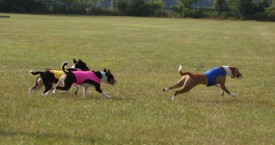
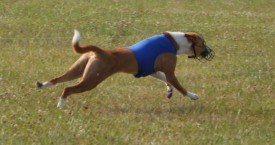
Dances with dogs draws on many skills; the obedience and ability of your dog to perform ‘tricks’ and the handlers ability to make a sensational choreographed routines.
It may sound easy, but it is highly challenging as your dog learns to heal backwards, weave between your legs as your are walking, spin, reversing around props and balancing on his hind legs.
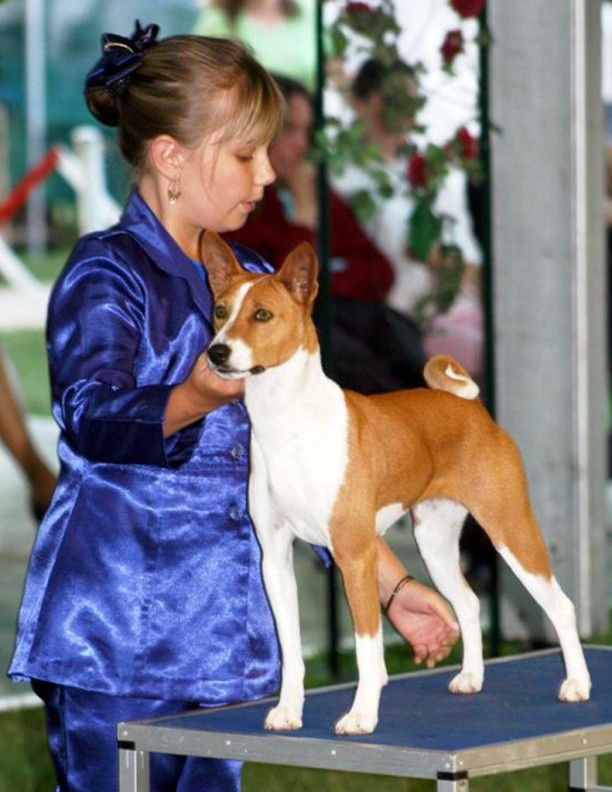
The Victorian Basenji Breed Association encourages our younger members to participate in dog sport. We believe it is critical to have a succession plan for our breed. To encourage young family members into the rewarding pastime will ensure that the world of pure bred dogs has a future.
The young people also learn skills, meeting and talking to people from all different walks of life. You might be a university professor, a doctor or 8 year old boy once in the ring you are all on the same footing.
There is nothing so rewarding as a weekend away, traveling to a dog show or event somewhere, with your favourite canine companion at your side. And perhaps coming home with a blue, red or white ribbon as a reward for a job well done.
Junior handlers teaches young people many skills, memory, interaction with people of all ages, courtesy, sportsmanship and animal management.

